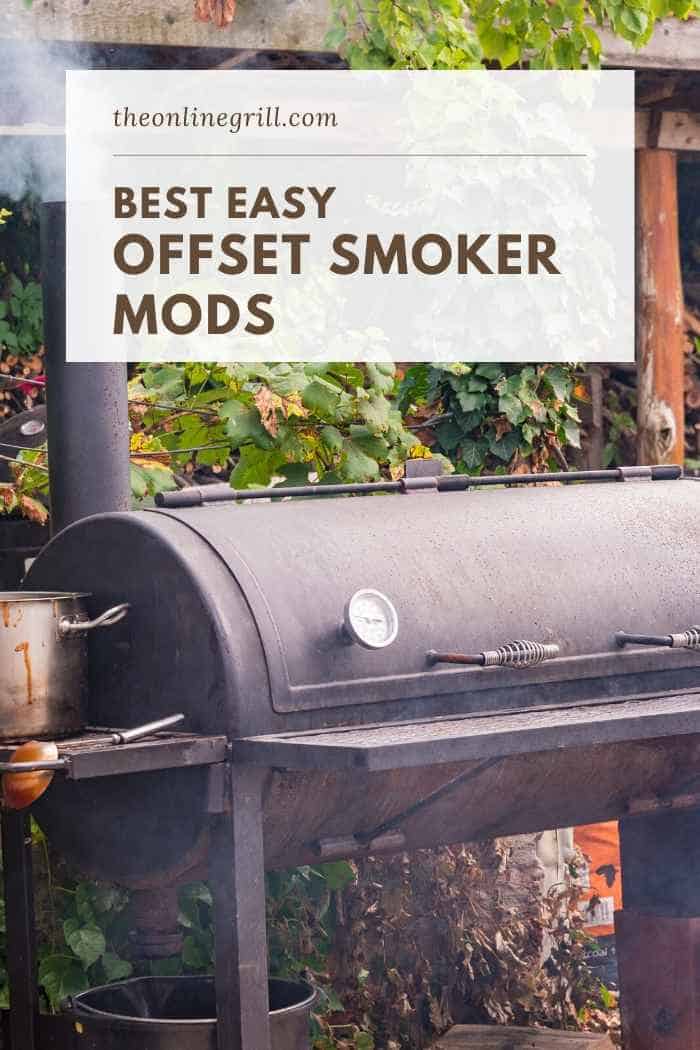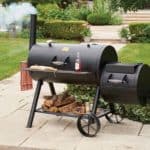Check out these easy upgrades you can get for your offset smoker today. From ways to improve its heat distribution, to simple wheel upgrades, there’s something here for anyone looking to get the best smoker for their backyard or patio.

Are you struggling to get a good performance out of your offset smoker?
Or have you bought a low-end model and not sure where to start in tuning it up to a BBQ beast?
Charcoal offset smokers might not have the fancy add-ons that electric of gas-fuelled smokers do, but if you can get them right they sure do make the best food. Not only that, but the best thing about charcoal or wood fuelled models is that they are much easier to modify and upgrade.
You can add hundreds of dollars’ worth of value simply by adding a handful of tweaks, and all for about $50.
Here are 8 easy steps you can follow to upgrade your current model with these hand offset smoker mods.
This article could literally save you thousands of dollars in unnecessary costs, so listen up!
Why do you need to upgrade your current smoker?
Everyone might have a different motivation for seeking an upgrade, but there are always a few tell-tale signs that a smoker is due some much needed TLC. Here are the most common issues.
Thin steel construction
Offset smokers tend to be made with steel that’s thinner and more slight than electric smokers. It’s not uncommon to see materials that are about 1/8 -inch thick or even thinner.
While this can make them easier to move around, thinner metal doesn’t hold heat particularly well.
High-end models tend to be made with ¼-inch steel or thicker.
Heat loss
Loss of cooking temperature is the bane of any pit master’s life, and if your smoker is prone to heat escaping, then you’ll always be fighting an uphill battle.
If the construction of your offset smoker is weak, then you’re likely to experience heat loss between the firebox and the main chamber. Similarly, if the door isn’t well built, then you’re likely to see heat loss there too.
If the firebox and doors are well sealed, then you’ll be able to control temperatures much more efficiently without the fear of heat leaking while you cook.
Poor quality wheels
The majority of low-grade smokers are built with saving construction costs as a priority. This means that ‘non-essential’ components are extremely components.
Nowhere is this more evident than with wheels.
The vast majority of budget-friendly smokers that I’ve seen are built upon extremely poor quality wheels.
Even if you don’t intend on moving your smoker a lot, there will be times where you need to move it in or out of storage, or if you need to move it slightly to get out the way of heavy wind or rain.
Having to do this with shoddy wheels is really frustrating. Luckily, these can be upgraded very easily.
Here are the best offset smoker mods you can make today to get the very most out of your barbecue.
Tuning plates
Adding tuning plates is one of the easiest and quickest ways to help combat heat loss from your smoker’s chamber.

Tuning plates are plates of steel that you fit in the bottom of your smoker chamber. These serve a couple of essential purposes.
One is that they help reflect heat inside your chamber, helping to distribute it from near the firebox to the other end of your chamber. This helps heat distribution significantly, helping you to have much more even cooking temperatures across the entire cooking surface of your unit.
Their second vital function is that they can absorb heat, locking it in each time you need to open the chamber.
This will help your smoker retain cooking temperatures, and minimize the impact of you opening the chamber door.
This makes tuning plates a fantastic way to combat the adverse effects of thin steel construction.
Recommended tuning plate
Take a look at these plates from Oklahoma Joe for a good idea of what you need to look out for. Also available on BBQSmokerMods.com.
How to install tuning plates in an offset smoker
Thankfully, tuning plates are relatively inexpensive and easy to buy. They often can be purchased individually, so there’s no need to buy them in bulk.
Check if your smoker has slots for inserting tuning plates, and also check the height of the slots. Usually, the height sits somewhere between 20 and 30 centimeters, but you’ll take note, so you know what plates to buy.
Once you have your plates, wash them thoroughly with standard dish soap. This will help remove any grease or oil that can latch itself onto parts when they’re manufactured.
Slot each plate individually in line with the slots in your smoker. Don’t leave any gaps between them, and ensure that they are in contact with one another. This will provide excellent heat conduction between plates.
Smoker blanket or cover
If you’re cooking in colder temperatures, then I recommend using a welding blanket on your smoker while it cooks.
This will help lock in heat a lot better, and because you’re not having to check food every couple of minutes, it won’t get in the way too much.
If your smoker is built with thin metal, then a good blanket will give it a much-needed boost.
Be sure that the cover doesn’t lie over your smoker’s dampers, as these are crucial for airflow and cooking temperatures.
Don’t buy a standard smoker cover – these are designed to also cover the dampers. Instead, get a fiberglass welding blanket and simply drape that over the smoker.
Smoker sealant
One of the biggest culprits for heat loss in smokers is poor construction between the firebox and chamber, as well as the frame around the door.
I recommend using a high-temperature food-grade silicone sealant between the firebox and chamber, as well as any other connecting parts that could be prone to leaking.
Be sure to use something FDA approved, as it’ll be in indirect contact with your food. You don’t want anything that has a nasty chemical footprint.
Firebox sealant
Most offset smokers’ fireboxes have a top door for dropping coals into. This can often be another vulnerable point where we can encounter heat loss.
Luckily, we don’t have to apply a food-safe sealant here, so we can use something more durable with a higher heat threshold.
Use a high-temperature gasket material. These can often withstand temperatures of up to 1000°F, which is more than enough for burning coal.
This should ensure that your firebox door locks in the heat generated by your coals.
Charcoal basket
Charcoal baskets help to improve air and heat flow through your smoker by keeping the coals in your firebox off the floor.
You can’t buy these ready-made, but you can easily make one yourself.
Door seal
Poorly constructed chamber doors are an easy point for heat to escape through. Use a suitable quality sealant that will help minimize the loss of heat while the door is shut.
Try this door seal gasket from FireBlack
This gasket from Fireblack can fit in the fitting around your door, and withstand temperatures of up to about 800°F. More than enough for BBQ smoking.
Toggle clamps
They might look awkward, but using toggle clamps to firmly close your smoker door is a great way to lock in temperature.
Getting a couple won’t cost you much and is a surefire to guaranteeing that your door stays firmly in place.
New wheels
Our beloved, often forgotten friend, the wheel.
Decent wheels might not be high up on your list of priorities, but anyone who has tried to move their smoker on shoddy wheels will know the pain they cause.
A decent set of wheels will only cost you between $10-20 but will make a world of difference.
Try these multi purpose wheels
Look out for air-filled wheels and rubber, to ensure maximum maneuverability.
There you have it. Upgrading your offset smoker might seem daunting, but with just a few simple tweaks, you can improve the performance tenfold.
By improving heat retention and heat distribution, you will have done enough to get your smoker to rival high-end models, all while only spending under $100.
So before you consider splashing out on an entirely new model, have a go at these tweaks and watch your smoker’s heat performance skyrocket!









